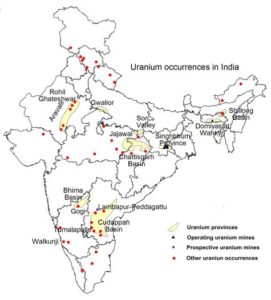Uranium Found in Aravallis- Government Authorities May Soon Mine It
 Can India have its yellow cake and eat it too?
Can India have its yellow cake and eat it too?
The first preliminary survey indicates that there are traces and other mineral deposits in the mountain range, and the Atomic Directorate for Exploration and Research (AMD) is conducting a second round of survey in Rajasthan.
 Indian nuclear plants have sourced uranium from Andhra Pradesh. Tummalapalle village located in the Kadapa district of Andhra Pradesh is considered as one of the largest uranium reserves in the world according to results from research conducted by the Atomic Energy Commission of India in 2011.
Indian nuclear plants have sourced uranium from Andhra Pradesh. Tummalapalle village located in the Kadapa district of Andhra Pradesh is considered as one of the largest uranium reserves in the world according to results from research conducted by the Atomic Energy Commission of India in 2011.
Recent findings from the preliminary survey show that further survey in Alwar, Jaipur, Bharatpur and Dausa is required. If successful, the government will begin mining in the state to get enough of the nuclear fuel.
The survey hints that Aravali range may be one of the most uranium-rich areas in the country after Andhra Pradesh and Jharkhand. The first phase was conducted in March in areas of the Aravalli Hills, like Sariska, Tijara, Bandikul, part of Alwar city, Kotapuli and Bharatpur.
Unfortunately, as it turns out, most of these areas are, and have been marked as ecologially sensitive, having already borne the brunt of extensive illegal mining for limestone, marbles and more. How the Uranium mining proposal will move ahead considering all the environmental issues would be very interesting to see.
Public sector undertaking-Uranium Corporation of India Ltd (UCIL), which works under the department of atomic energy, is responsible for exploring the nuclear fuel and has been working to become self-sufficient in Uranium production.
India and its relationship with nuclear power, has been quite amazing. Very little discussion has Nuclear power actually generated in the public domain. India has to cut down on its ‘dirty fuel’ portfolio (read-Coal plants), nuclear power remains a critical option to supply its core power needs. Anil Kakodkar, former chairman of the Atomic Energy Commission of India spoke with us about India’s energy future. He was clear in his views that we need to be pragmatic about nuclear power. Be it dependable supply, the involvement of public and private sectors together, cost, and finally scale, nuclear ticks all the right boxes, in his view.
India Ratings and Research released a report in October this year, highlighting the trends in the power sector. According to the report by India Ratings, increase in power demand was met through higher electricity generation, which increased 11.7% year-on-year to 105.7 billion units, especially driven by a healthy year-on-year rise in generation from hydro/hydel sources by 20% and nuclear by 18.1%.
In May, Australian PM Turnbull declared about two Australian companies BHP Billiton (worlds’ largest mining company) and Heathgate Resources (an affiliate of General Atomics) confirmed that they are in talks with the Department of Atomic Energy (DAE) for exporting Uranium to the country.
The imported uranium from Australia would be used for the Indian nuclear reactors that are under the International Atomic Energy Agency (IAEA) safeguards. Up till now, India has received fuel from Russia’s JSC TVEL, Kazakhstan’s JSC NAC KazatomProm, France’s Areva and Canada’s Cameco. Canada’s Cameco this November announced its plan to boost its Indian operations too.
Uranium fell out of favor after the Fukushima nuclear disaster in 2011, which led to plant closures in Japan and Germany and a slowdown in plant-building elsewhere. Uranium, or plutonium, which is made from it, is an essential nuclear fuel. However recently, Uranium’s spot price has jumped by 41% since April, to near a two-year high and the long-term trend seems clear. Global demand is expected to rise by 44% by 2035. China has 19 nuclear reactors under construction and 41 more planned. India is building six and considering another 15. Saudi Arabia is seeking to award its first two projects; Egypt, Jordan, Turkey and the United Arab Emirates have announced programmes. All this will require new mines besides ones located in Kazakhstan and Africa.
Picture credit: AMU, Geology Department







